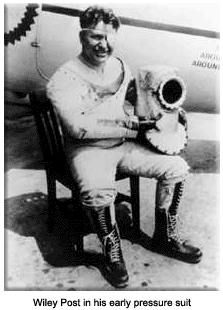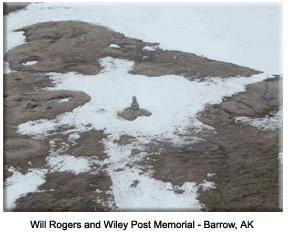 On August 15, 1935, the world lost not only a great flier in Wiley Post, but his good friend and world-renowned humorist, Will Rogers.
Post set the record for flying around the world on two occasions: in June 1931, eight days, 16 hours, with navigator Harold Gatty; then in July 1933, seven days, 19 hours. The second one he flew solo.
Childhood and first love
Wiley Hardman Post was born in November 1898, in Grand Saline, Texas, to William Frances and Mae Laine Post, who made their living as farmers. The family moved to Oklahoma when he was five years old. He dropped out of school when he was in the eighth grade.
Wiley's love for mechanical devices became evident during a trip to a county fair in 1913. He saw his first airplane and knew immediately that he wanted to become an aviator. Wiley, however, was practical and began work as a mechanic in an oil field instead, but he never forgot his dream to become a pilot.
Jumping into aviation
Post broke into aviation in 1924, when a barnstorming troupe came to Oklahoma. The troupe's skydiver was injured, so Post convinced the owner that he should let him fill in.
Post had no experience, but he made the jump. He jumped 99 times over the next two years, earning as much as $200 a dive. But Post’s dream was to be a pilot, not a skydiver; he decided to return to the oil fields to make enough money to buy his own aircraft.
An accident and an opportunity
In 1926, a serious accident jeopardized Post's dream to be an aviator. A stray chip hit him in his left eye. A massive infection developed and began to affect both eyes. Doctors feared Post would become blind, so they persuaded him to have his left eye removed, in hopes to save the other eye.
Having only one eye, Post had trouble with depth perception, but he trained himself to gauge distances through practice; he learned to land a plane by using the height of telephone poles and two-story buildings.
With his $1,800 worker's compensation check, Post bought his first airplane, a Curtiss Canuck. He made a living for the next few years by teaching student pilots, flying oilmen to their rigs, and barnstorming on weekends.
Post became the personal pilot for F.C. Hall, an important oilman. Hall was an aviation enthusiast and owned a Lockheed Vega, one of the era's most advanced airplanes; he had named the plane the Winnie Mae, after his daughter. Aware of Post's aviation ambitions, Hall encouraged him to fly his plane, when not otherwise in use.
Sky racing
Post entered the 1930 Men's Air Derby Race, from Los Angeles to Chicago. After he won by more than one and a half hours — with a faulty compass — Hall told Post he could use his aircraft to pursue any records he wished. That inspired an attempt at a new speed record for around-the-world travel.
Post chose Harold Gatty, a well-known Australian navigator and aviator, to assist him with his new attempt. While Gatty plotted the route, Post made several changes to the Winnie Mae, including an improved instrument panel, adjustable seats, and a special navigation station.
On June 23, 1931, Post and Gatty took off from Roosevelt Field, Long Island. After eight days, 15 hours, and 51 minutes, they landed back on Long Island on July 1 and established the new time record.
Deciding to prove to the world that he could make the flight alone, Post took off from Floyd Bennett Field, Long Island, on July 15, 1933. He flew solo around the world in the Winnie Mae and set a new world record of seven days, 18 hours, and 49 minutes. Post made better time than his previous record by 21 hours.
Post's next goal was to win the MacRobertson Race, from England to Australia. Along with the B.F. Goodrich Rubber Company, Post developed a pressurized suit that would enable him to fly in the substratosphere at 30,000 to 40,000 feet in altitude — where the air is thinner and an aircraft can travel much faster.
However, by the time the suit had been perfected, the MacRobertson race had come and gone. Post decided to use his new suit to try to set a transcontinental flight record instead.
Post completed four attempts at the record, but was never able to break it. Nevertheless, he set a new air speed record during one of the flights, by traveling 2,035 miles in seven hours and 19 minutes, thus confirming that high-altitude flight was a key to faster air speeds.
On August 15, 1935, the world lost not only a great flier in Wiley Post, but his good friend and world-renowned humorist, Will Rogers.
Post set the record for flying around the world on two occasions: in June 1931, eight days, 16 hours, with navigator Harold Gatty; then in July 1933, seven days, 19 hours. The second one he flew solo.
Childhood and first love
Wiley Hardman Post was born in November 1898, in Grand Saline, Texas, to William Frances and Mae Laine Post, who made their living as farmers. The family moved to Oklahoma when he was five years old. He dropped out of school when he was in the eighth grade.
Wiley's love for mechanical devices became evident during a trip to a county fair in 1913. He saw his first airplane and knew immediately that he wanted to become an aviator. Wiley, however, was practical and began work as a mechanic in an oil field instead, but he never forgot his dream to become a pilot.
Jumping into aviation
Post broke into aviation in 1924, when a barnstorming troupe came to Oklahoma. The troupe's skydiver was injured, so Post convinced the owner that he should let him fill in.
Post had no experience, but he made the jump. He jumped 99 times over the next two years, earning as much as $200 a dive. But Post’s dream was to be a pilot, not a skydiver; he decided to return to the oil fields to make enough money to buy his own aircraft.
An accident and an opportunity
In 1926, a serious accident jeopardized Post's dream to be an aviator. A stray chip hit him in his left eye. A massive infection developed and began to affect both eyes. Doctors feared Post would become blind, so they persuaded him to have his left eye removed, in hopes to save the other eye.
Having only one eye, Post had trouble with depth perception, but he trained himself to gauge distances through practice; he learned to land a plane by using the height of telephone poles and two-story buildings.
With his $1,800 worker's compensation check, Post bought his first airplane, a Curtiss Canuck. He made a living for the next few years by teaching student pilots, flying oilmen to their rigs, and barnstorming on weekends.
Post became the personal pilot for F.C. Hall, an important oilman. Hall was an aviation enthusiast and owned a Lockheed Vega, one of the era's most advanced airplanes; he had named the plane the Winnie Mae, after his daughter. Aware of Post's aviation ambitions, Hall encouraged him to fly his plane, when not otherwise in use.
Sky racing
Post entered the 1930 Men's Air Derby Race, from Los Angeles to Chicago. After he won by more than one and a half hours — with a faulty compass — Hall told Post he could use his aircraft to pursue any records he wished. That inspired an attempt at a new speed record for around-the-world travel.
Post chose Harold Gatty, a well-known Australian navigator and aviator, to assist him with his new attempt. While Gatty plotted the route, Post made several changes to the Winnie Mae, including an improved instrument panel, adjustable seats, and a special navigation station.
On June 23, 1931, Post and Gatty took off from Roosevelt Field, Long Island. After eight days, 15 hours, and 51 minutes, they landed back on Long Island on July 1 and established the new time record.
Deciding to prove to the world that he could make the flight alone, Post took off from Floyd Bennett Field, Long Island, on July 15, 1933. He flew solo around the world in the Winnie Mae and set a new world record of seven days, 18 hours, and 49 minutes. Post made better time than his previous record by 21 hours.
Post's next goal was to win the MacRobertson Race, from England to Australia. Along with the B.F. Goodrich Rubber Company, Post developed a pressurized suit that would enable him to fly in the substratosphere at 30,000 to 40,000 feet in altitude — where the air is thinner and an aircraft can travel much faster.
However, by the time the suit had been perfected, the MacRobertson race had come and gone. Post decided to use his new suit to try to set a transcontinental flight record instead.
Post completed four attempts at the record, but was never able to break it. Nevertheless, he set a new air speed record during one of the flights, by traveling 2,035 miles in seven hours and 19 minutes, thus confirming that high-altitude flight was a key to faster air speeds.
 A lake in Alaska
In 1935, Post and Rogers, one of Post's close friends, took off from Point Barrow, Alaska, in an airplane that Post had modified. Shortly after takeoff, the craft — which was nose heavy — crashed into a lake, killing both men. America mourned the loss of two famous and beloved national figures.
Wiley Post was one of the world's great aviation pioneers. Many people thought that his solo trans-global flight was his most significant accomplishment, but his development of the pressurized suit, and his substratospheric flight, had a much greater impact on aviation and the advances in the theory of flight.
Regardless of which of Post's accomplishments one considers his greatest, it is clear that he made many vital contributions to aviation.
A lake in Alaska
In 1935, Post and Rogers, one of Post's close friends, took off from Point Barrow, Alaska, in an airplane that Post had modified. Shortly after takeoff, the craft — which was nose heavy — crashed into a lake, killing both men. America mourned the loss of two famous and beloved national figures.
Wiley Post was one of the world's great aviation pioneers. Many people thought that his solo trans-global flight was his most significant accomplishment, but his development of the pressurized suit, and his substratospheric flight, had a much greater impact on aviation and the advances in the theory of flight.
Regardless of which of Post's accomplishments one considers his greatest, it is clear that he made many vital contributions to aviation.